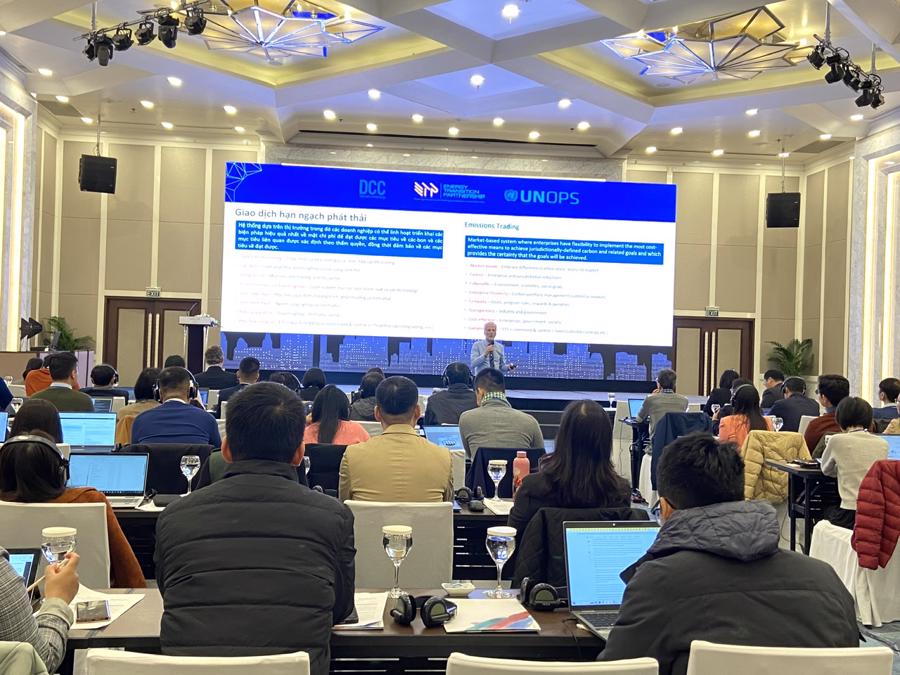From 26/2 – 1/3/2024, the Southeast Asia Energy Transition Partnership (ETP) program is organizing two training courses on the Emissions Trading System (ETS) and carbon markets for relevant state agencies, organizations, and businesses in Hanoi.
COMPANIES THAT HAVE IMPLEMENTED SURPLUS GREENHOUSE GAS AUDITS
The first training course took place on 26 and 27/2/2024 with the participation of representatives from ministries and sectors involved in the establishment and operation of the carbon credit trading platform and carbon market in Vietnam, as well as development organizations, financial organizations and other stakeholders.
The second training course is designed specifically for representatives of energy-intensive businesses, business associations, and media agencies, taking place on 29/2 and 1/3/2024.
These training courses are part of ETP’s support activities to promote the implementation of the carbon market in Vietnam in collaboration with the Climate Change Office (Ministry of Natural Resources and Environment). They are also part of the Technical Assistance (TA) “Training and Simulation of the ETS in Vietnam” by ETP.
This is the first capacity-building activity in Vietnam to attract the participation of stakeholders from both the public and private sectors with a comprehensive and systematic training program on ETS and carbon markets combined with the use of market simulation tools.

The lectures are built and presented by leading international experts in climate mitigation and carbon pricing. This training initiative takes place at an important stage when Vietnam is committed to reducing greenhouse gas emissions under the obligations of the Paris Agreement.
Ms. Dang Hong Hanh, Team Leader and Expert on Climate Policies, Co-founder, and CEO of the Energy and Environment Consulting Joint Stock Company (VNEEC), said that VNEEC has surveyed 537 businesses in the fields of industry, trade, construction, waste treatment, and transportation nationwide with estimated emissions of over 10,000 tons of CO2 equivalent.
These businesses are expected to participate in the pilot phase of implementing ETS in Vietnam, among the 1,912 businesses required to report greenhouse gas inventories according to the Prime Minister’s decision.
The survey results show that the number of businesses that have conducted greenhouse gas inventories is still limited, accounting for nearly 32%, mostly through third-party audits; the remaining majority do it themselves.
57.38% of businesses are preparing to develop greenhouse gas emissions reduction plans, while a small number – nearly 28% – already have greenhouse gas emissions reduction plans.
It is worth noting that businesses’ understanding of ETS and carbon markets is still very limited. Over 50% of businesses have heard of ETS and carbon markets but are not familiar with the basic principles of operation, and a few do not know where ETS and carbon markets are, and only a very small number – 1.27% of businesses – understand how ETS and carbon markets work.
“This shows that there is a great demand for training on the Emissions Trading System and carbon markets,” Ms. Hanh emphasized.
Nevertheless, according to Ms. Hanh, businesses’ readiness to learn about this issue is quite high. The majority of businesses want to participate in ETS training courses, learn about the objectives of carbon emissions reduction, etc.
CARBON PRICING – THE CORE TOOL FOR REDUCING GREENHOUSE GAS EMISSIONS
With the voluntary goals of reducing 15.8% and 43.5% greenhouse gas emissions with international support compared to the normal emissions scenario by 2030, Ms. Hanh believes that building an effective ETS plays a key role in achieving the contribution as determined by the country’s Nationally Determined Contribution (NDC).
By setting a cap on total emissions and allowing companies to buy and sell emission allowances, ETS creates economic incentives for businesses to find cost-effective solutions for reducing their greenhouse gas emissions.
In addition, revenue from auctioning allowances can be reinvested in climate-related projects, further supporting the country’s efforts in the fight against climate change.
According to the roadmap, the Emissions Trading System and carbon credit mechanisms will be piloted from 2025 to 2027; businesses on the greenhouse gas inventory reporting list in March 2025 will have to report.
“There is not much time left for the pilot phase, so we need to prepare now. We have a short time to consolidate data and allocate it. Therefore, we need political determination and active participation from many stakeholders. We need to carry out multiple tasks in parallel and choose an appropriate pilot scale. It also requires many new technical and managerial requirements, as well as significant resources and the issuance of many legal documents and implementation guidelines in 2024,” Ms. Hanh emphasized.
Therefore, the main objective of technical support is to develop and organize ETS training courses for various stakeholders including policy-makers, research institutes, universities, financial organizations, media representatives, and especially large emitters who will have to participate in Vietnam’s ETS in the future.
Agreeing with that, Ms. Roxanne Tan, Senior Manager of Climate, Finance and Carbon Markets Policy at South Pole, stated that carbon pricing is currently the core of many countries’ greenhouse gas mitigation strategies.
Carbon pricing is an economic tool. By pricing carbon, the economic burden associated with the damage caused by greenhouse gas emissions is transferred to the emitting facilities responsible for it.
As a result, emitting facilities have the flexibility to decide on the most cost-effective ways, locations, and timing to reduce emissions.
Pricing is a powerful tool to drive a range of behavioral responses aimed at reducing energy use and transitioning to low-carbon fuels or processes. At the same time, it generates income for budgets, which can be used for various socio-economic aims.












